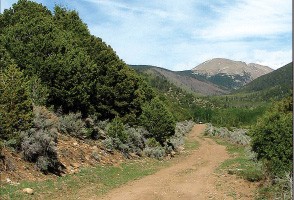Sangre de Cristo Land Grant rights affirmed

SAN LUIS — Heirs of a 1860s land grant have reaffirmed their rights to use the land.
This is due to an appellate division’s opinion upholding earlier decisions by the Colorado Supreme Court.
“I am happy to announce that the Colorado Appellate Court has ruled in favor of the heirs/access holders in Lobato v Taylor,” said Shirley Romero-Otero, president of the San Luis Land Rights Council, which was formed to fight Taylor’s push to deny access to the ranch. More than 150 individuals and youth attended a hearing on September 5 in Denver.
“A sincere thank you to all of our supporters on that day and the past 37 years that this case has been in the courts,” Romero-Otero said. “Hasta la Victoria, siempre!”
Houston’s William Bruce Harrison, a 31-year-old heir to one of Texas’ biggest oil fortunes, bought the 83,000-acre Cielo Vista Ranch a year ago, shortly after it listed for $105 million.
Within months after the purchase, Harrison appealed a 2002 high court decision —15 years after the supreme court remanded this case to the district court with instructions to “identify all landowners who have access rights to the Taylor Ranch,” a division of the court of appeals reviewed whether the district court’s proceedings on remand discharged the mandate.
Harrison claimed he had no way of knowing who those heirs were or who was on the ranchlands and complained that those using the land were damaging it.
This was vehemently denied by heirs who had keys to the locked gates and were using the land for sustenance.
The high court’s decisions in Lobato v. Taylor cases constitute the mandate in this case, the appeals court determined.
Those decisions held that present day San Luis Valley landowners had the right to access the Taylor Ranch — now the Cielo Vista Ranch owned by Harrison — upon showing their land was settled by 1869.
Charles Beaubien persuaded families from New Mexico to settle the lands, issuing a letter affirming their rights to graze their animals and gather wood and timber from the forested, mountainous areas nearby.
In 2004, the district court began identifying and decreeing access rights for landowners in the San Luis Valley whose forefathers settled the grant by 1869.
From 2004 until 2010, the district court relied on the best available evidence to decree access rights for individual landowners without requiring any landowner to come forward to assert a claim. This changed in 2010 and the district court decreed access rights for only those landowners who came forward to assert claims.
In their opinion issued November 15, the appellate division concluded the proceedings on remand were largely consistent with the mandate, but the district court did not completely discharge its mandate because the identification process used after 2010 could have been, but was not, comprehensive.
The division concluded that the undisputed evidence would enable the district court to “identify all landowners who have access rights,” and, therefore, remands for the district court to completely discharge its mandate by identifying all current owners of lands which the undisputed evidence shows were settled as of 1869.
Within months of Harrison buying the property, the process of identifying, surveying and certifying original settlers of the ranch concluded, granting access to about 6,400 parcels of land to nearly 5,000 descendants of Spanish and Mexican homesteaders who colonized the San Luis Valley before Colorado was a state.
The process was part of the 2002 Colorado Supreme Court decision — the second high-court decision in the decades-long range war — that restored historical access to descendants of the homesteaders, who were allowed to harvest timber and firewood for personal use, and graze a limited number of livestock.
Harrison bought the ranch from a group of Texas investors, who had purchased the property from disgraced Enron executive Lou Pai, who bought the ranch from North
Carolina lumber baron Jack T. Taylor in the late 1980s.
The first suit, filed in 1981 by Apolinar Rael, was dismissed, and then continued actions by ranch owners gave birth to the Lobato suits and the Land Rights Council in the 1970s.
All three previous owners had spent decades wrangling with locals who cited the historic land grant when seeking access to the ranch and had those rights reaffirmed in court.
Harrison continued that trend, appealing the 2002 decision, which could only be challenged after the certification process concluded last fall. In December, he sent letters to the land grant heirs, offering $300 for their rights to the ranch, an offer considered an insult by those who received the letters.
“All these previous owners have been white men with privilege and deep pockets and they continue to use both to deny us access to property that has been used by our fathers and mothers, their fathers and mothers, and their fathers and mothers,” Romero-Otero said.
The appellate decision upholds those rights.



